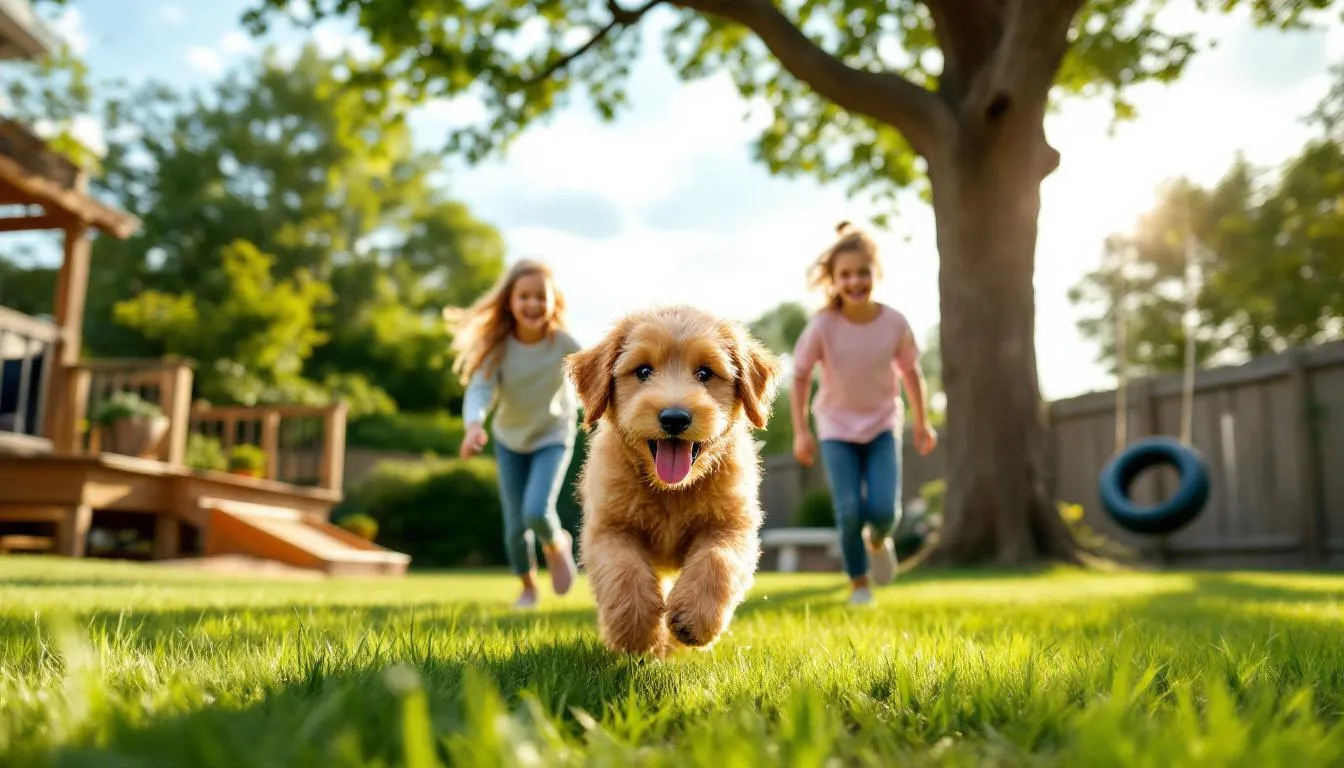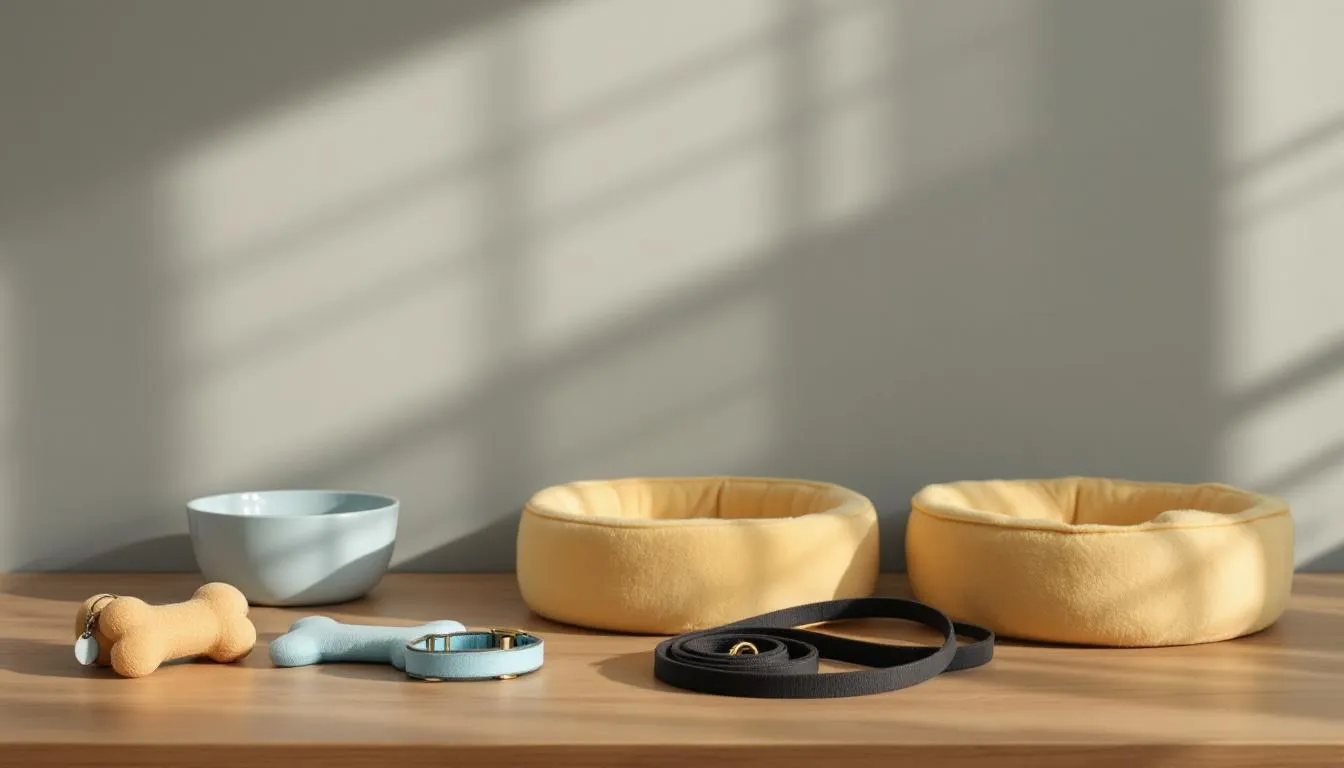

Key Takeaways
Imagine life with a dog who’s substantial enough for hiking adventures yet compact enough for cozy apartment living. Medium goldendoodle puppies offer exactly this sweet spot—a teddy bear companion that brings so much joy to families without overwhelming your home environment or lifestyle. These remarkable pups represent the most popular size among golden doodles, combining the best temperament traits from their parent dogs while maintaining a normal size that works for most families.
Medium goldendoodle puppies are especially cute, with their adorable appearance and charming personality making them irresistible to families and dog lovers alike.
Whether you’re first time dog owners or experienced puppy parents, medium goldendoodles deliver an amazing personality wrapped in a perfectly sized package. Let’s explore what makes these puppies such exceptional companions and how to find your perfect goldendoodle puppy.
What Are Medium Goldendoodle Puppies?
Medium goldendoodles represent the ideal middle ground in the golden doodle family. When fully grown, these dogs typically weigh between 30-50 pounds and stand 17-20 inches tall at the shoulder. This places them perfectly between the smaller mini goldendoodles (15-35 pounds) and the larger standard goldendoodles (51-80 pounds). Breeders often focus on producing mini, medium, and standard goldendoodles to offer families a range of size options to suit different preferences.
The breeding process involves crossing a purebred golden retriever with either a standard or miniature poodle, depending on the desired outcome. This careful selection creates a furry family member with the golden retriever’s gentle, family friendly nature and the poodle’s intelligence and reduced shedding qualities.
For families seeking the best dog for their lifestyle, medium goldendoodles offer remarkable versatility. They’re large enough to keep up with active kids and outdoor adventures, yet manageable enough for urban living and travel. This normal size makes them particularly appealing to families who want a substantial companion without the space requirements of larger breeds.
Compared to other goldendoodle varieties, mediums strike the perfect balance. They have more presence and stamina than minis, while remaining more manageable and less demanding than standards. This positioning has made them the most popular size among puppy owners seeking that “just right” companion.


Breeding and Genetics for Both Medium and Standard
Creating medium goldendoodles requires careful planning and exceptional health standards from responsible breeders. The medium size is typically achieved through specific crosses between parent dogs of complementary sizes. A standard poodle mother might be bred with a smaller golden retriever, or a medium english goldendoodle might result from crossing a miniature poodle with a larger golden retriever. A well-structured breeding program is essential for producing healthy, well-tempered medium goldendoodle puppies by ensuring quality, health testing, and proper socialization.
Quality breeding programs focus extensively on the genetic background of both parent dogs. Ethical breeding practices demand comprehensive health testing for hip dysplasia, elbow dysplasia, eye conditions, and genetic disorders common to both golden retrievers and poodles. This attention to genetic health helps ensure puppies develop into healthy adults with exceptional health throughout their lives.
The timing of breeding cycles plays a crucial role in successful litters. Female dogs typically cycle every 6-8 months, with optimal fertility periods lasting just a few days. Experienced breeders track these cycles carefully and often maintain waiting lists for specific litter dates, sometimes planning availability for seasons like summer 2025 litters well in advance.
Medium Golden Doodle Puppies Generations and Coat Types (In Home Considerations)
Understanding goldendoodle generations helps puppy parents choose the best temperament and coat characteristics for their family. Each generation offers different benefits:
F1 Generation : First-generation cross between a purebred golden retriever and poodle. These pups typically display the strongest hybrid vigor and most balanced temperaments, though coat predictability varies.
F1B Generation : Backcross of an F1 goldendoodle with a poodle (75% poodle, 25% golden retriever). F1B puppies usually have curlier, more hypoallergenic coats with minimal shedding—ideal for families with allergies.
F2 Generation : Cross between two F1 goldendoodles. These litters show the widest variation in coat types and temperaments.
F2B Generation : Backcross of an F1 with an F1B, resulting in approximately 62.5% poodle genetics. Like F1B, these tend toward curlier, low-shedding coats.
Multigen : Multiple generations of goldendoodle-to-goldendoodle breeding, offering more predictable traits.
Coat types fall into three main categories. Wavy coats blend characteristics from both parent breeds and are the most common. Curly coats resemble poodle fur closely and offer the best hypoallergenic qualities, though they require more intensive grooming. Straight coats look more like golden retriever fur and may shed more than other types.
For families prioritizing low-shedding qualities, F1B and F2B generations typically provide the best results, while F1 generations often display the most robust health and balanced temperaments.


Temperament and Personality Traits
Medium goldendoodle puppies inherit an amazing personality that makes them exceptional family companions. The combination of golden retriever gentleness and poodle intelligence creates dogs that are both smart and sweet, eager to please while remaining playful throughout their lives. They are known for having the sweetest temperament, making them especially loving, affectionate, and friendly additions to any home.
These puppies typically display remarkable social skills from early development. They’re naturally drawn to children and show patience during play that makes them ideal for families with kids of all ages. A well-bred goldendoodle puppy often becomes the sweet girl or good boy that bonds deeply with every family member while maintaining a special connection with their primary caregiver.
The intelligence inherited from both parent breeds makes medium goldendoodles highly trainable. They excel at potty training, often becoming reliably potty trained within weeks when approached with consistency and positive reinforcement. Their eagerness to learn extends beyond basic house rules to complex commands, tricks, and even therapy work.
Early socialization plays a crucial role in developing their best temperament. Puppies raised in home environments with exposure to various sounds, people, and other dogs typically grow into well behaved adults who adapt easily to new situations. This social nature means they thrive on interaction and may struggle with extended periods alone—they truly want to be part of family life.
Growth and Development Timeline
Understanding the growth timeline helps puppy parents prepare for their medium goldendoodle’s development. These puppies experience rapid growth during their first year, with specific milestones that help predict adult size.
8-16 Weeks : Puppies typically weigh 8-15 pounds and focus on basic socialization and early training. This period is crucial for establishing routines and beginning potty training.
4-6 Months : Weight ranges from 15-25 pounds. Puppies enter their most active growth phase and may seem to grow almost daily. Training becomes more formal, and many reach reliable house training.
6-12 Months : Weight increases to 25-40 pounds. Growth rate slows, but puppies still gain height and begin filling out. An 11-month-old might weigh around 28 pounds and appear nearly full-grown.
12-18 Months : Most medium goldendoodles reach their full height by 12-16 months, typically standing their adult 17-20 inches. However, they continue building muscle and developing their final body composition until approximately 18 months.
Throughout this timeline, proper nutrition and exercise support healthy development. Overfeeding can stress growing joints, while adequate exercise helps build strong muscles and bones. Regular veterinary checkups ensure puppies stay on track for optimal growth and well being.
The beauty of medium goldendoodles lies in their predictable size range. Unlike some mixed breeds where adult size remains uncertain, responsible breeding programs help ensure these puppies will mature into that perfect medium range that works so well for most families.


Living Requirements and Adaptability
Medium goldendoodles excel at adapting to various living situations, making them suitable for diverse family lifestyles. Their normal size allows them to thrive in apartments while having enough presence for homes with large yards. This versatility explains why they’ve become such popular companions for families across different housing situations.
For apartment living, medium goldendoodles offer significant advantages over standard goldendoodles. They require less space for indoor exercise and are easier to manage during elevator rides or stair climbing. A half hour of morning exercise combined with interactive indoor play often meets their daily activity needs in smaller spaces.
Families with yards find these dogs equally content. They enjoy outdoor exploration and games of fetch, but they’re not so large that they overwhelm garden spaces or become destructive. Their moderate exercise needs—typically 45-60 minutes daily—fit well with busy family schedules.
The adaptability extends to family composition. Singles appreciate their companionship and moderate size, while families with multiple children find them sturdy enough for active play. Even seniors often find medium goldendoodles more manageable than larger breeds while still providing the substantial presence many people prefer in a dog.
Travel compatibility is another significant advantage. Medium goldendoodles fit comfortably in most vehicles and can often accompany families on vacations where larger dogs might face restrictions. Their friendly temperament and moderate size make them welcome in many pet-friendly accommodations. Additionally, medium goldendoodles are well-socialized and prepared to thrive in the world beyond their home environment, making them confident and adaptable companions wherever life takes them.
Health and Well-being
Medium goldendoodles are celebrated for their exceptional health and overall well-being, a testament to the thoughtful breeding practices of reputable breeders. By combining the robust genetics of a purebred golden retriever with the intelligence and vitality of a poodle, these goldendoodles inherit the best qualities from both parent breeds. This careful approach to breeding helps ensure that your furry family member enjoys a long, healthy life filled with joy and companionship.
To support their well being, it’s important for families to provide regular veterinary check-ups, a balanced diet tailored to their medium size, and plenty of daily exercise. These steps help maintain their healthy weight, strong joints, and shiny coats, allowing them to thrive in any home environment. Medium goldendoodles are known for their resilience and adaptability, but their health flourishes most when their physical and emotional needs are met.
By prioritizing the health of your goldendoodle, you’re not just investing in their longevity—you’re also ensuring that every day spent together is filled with happiness and vitality. With the right care, your medium goldendoodle will be a source of so much joy, enriching the lives of everyone in the family for years to come.
Training and Socialization
Training and early socialization are at the heart of raising a well behaved and joyful medium goldendoodle. Thanks to their intelligence and eagerness to please, these dogs are quick learners who thrive on positive reinforcement. Potty training is often a smooth process with medium goldendoodles, as they respond well to consistent routines and gentle encouragement. Many puppy owners find their goldendoodle puppy becomes reliably potty trained within just a few weeks, making the transition to family life even more enjoyable.
Early socialization is equally important, helping your puppy develop confidence and good manners around other dogs, new people, and a variety of environments. Introducing your goldendoodle to different sights, sounds, and experiences during their formative weeks sets the stage for a lifetime of positive interactions. Whether it’s meeting neighborhood dogs on a walk or greeting visitors at home, early socialization ensures your goldendoodle grows into a friendly, adaptable companion.
With the right training and socialization, medium goldendoodles become the well behaved, loving dogs that bring so much joy to families. Their playful spirit and gentle nature make every day brighter, and their ability to learn quickly means they’re always ready for new adventures and family fun.
Family Life with a Goldendoodle
Imagine life with a medium goldendoodle—a dog who truly embodies the best dog qualities for families of all shapes and sizes. These goldendoodles are renowned for their family friendly temperament, blending playfulness with a gentle, loving nature that makes them perfect companions for kids and adults alike. Whether you’re looking for a best boy to join in backyard games or a sweet, cuddly friend for quiet evenings at home, medium goldendoodles fit seamlessly into family life.
Their medium size means they’re just right for a variety of living situations, from bustling households with children to quieter homes with seniors. Goldendoodles are known for their patience and adaptability, making them a wonderful choice for families with kids who want a playful yet gentle dog. Their low-shedding, hypoallergenic coats are an added bonus, especially for families with allergy concerns.
As a breed, medium goldendoodles quickly become an integral part of the family, offering companionship, laughter, and unconditional love. It’s no wonder so many families consider them the best dog they’ve ever had—once you welcome a goldendoodle into your home, it’s hard to imagine life without their joyful presence. Every day with a goldendoodle is filled with happiness, making them the perfect addition to any loving family.
Choosing a Quality Breeder
Finding the right breeder is crucial for bringing home a healthy, well-socialized goldendoodle puppy. Ethical breeding practices and high standards separate responsible breeders from puppy mills or backyard operations that prioritize profit over puppy welfare.
Look for breeders who follow standard breeding practices including comprehensive health testing of parent dogs. Quality breeding programs test for hip dysplasia, elbow dysplasia, progressive retinal atrophy, and other genetic conditions common to golden retrievers and poodles. These tests should be verifiable through organizations like OFA (Orthopedic Foundation for Animals) or PennHIP.
The Goldendoodle Association of North America (GANA) provides valuable breeder certification with Gold, Silver, and Bronze rankings based on health testing, breeding practices, and ethical standards. Gold-level breeders represent the highest health standards and most comprehensive testing protocols.
Pay attention to where puppies are raised. In home environments typically produce better-socialized puppies compared to outdoor kennels or commercial facilities. Puppies raised as part of the breeder’s family experience household sounds, different people, and daily routines that prepare them for life in your loving home. Responsible breeders are committed to placing their puppies in loving homes where they will be cared for and cherished.
Reputable breeders offer lifetime support and are available to answer questions throughout your dog’s life. They often provide detailed contracts, health guarantees, and require spay/neuter agreements for pet-quality puppies. Many maintain relationships with puppy parents through social media groups or regular updates.
Be prepared for waiting lists, especially for popular times like summer litters. Quality breeders often have limited litters per year and prioritize careful matching of puppies to families. Payment options typically include deposits to secure your spot, with many breeders accepting money order or other secure payment methods.


Preparing for Your Medium Goldendoodle Puppy
Preparation is key to ensuring your new furry family member transitions smoothly into your home environment. Creating a comprehensive checklist helps ensure you have everything needed for those first crucial weeks.
Essential Supplies Checklist
- Appropriately sized crate (30-36 inches for adult medium size)
- Food and water bowls (stainless steel or ceramic preferred)
- High-quality puppy food recommended by your breeder
- Collar and leash appropriate for growing puppies
- ID tags with your contact information
- Variety of safe chew toys for teething
- Comfortable bedding for crate and sleep areas
- Basic grooming supplies: brush, nail clippers, puppy shampoo
- Cleaning supplies for house training accidents
- Baby gates for safe area containment
Appropriately sized crate (30-36 inches for adult medium size)
Food and water bowls (stainless steel or ceramic preferred)
High-quality puppy food recommended by your breeder
Collar and leash appropriate for growing puppies
ID tags with your contact information
Variety of safe chew toys for teething
Comfortable bedding for crate and sleep areas
Basic grooming supplies: brush, nail clippers, puppy shampoo
Cleaning supplies for house training accidents
Baby gates for safe area containment
Puppy-proofing requires special attention to the medium size range. Remove items at the height a 20-30 pound puppy might reach, secure electrical cords, and ensure no toxic plants or foods are accessible. Consider your puppy’s eventual size when planning spaces—what’s safe for a small pup might not work for a 40-pound adolescent.
Early socialization begins the moment your puppy arrives. Plan controlled introductions to family members, safe spaces for initial exploration, and a consistent routine for feeding, potty breaks, and sleep. The first few weeks establish patterns that influence your dog’s entire life.
Training preparation should include researching positive reinforcement methods, locating puppy kindergarten classes, and establishing household rules all family members will follow consistently. Consider whether you’ll crate train, what areas of the house will be accessible, and how you’ll handle the adoption process transition.
We hope these preparation tips help you enjoy a smooth and joyful transition with your medium goldendoodle puppy.
FAQ
How can I predict if my goldendoodle puppy will stay medium-sized?
While no prediction is 100% certain, reputable breeders can provide fairly accurate size estimates based on the parent dogs’ weights and previous litter outcomes. Most medium goldendoodle puppies from proven breeding lines stay within the 30-50 pound range. At 16 weeks, puppies are typically about half their adult weight, so a 16-week-old weighing 20 pounds will likely mature to around 40 pounds. Your breeder’s experience with previous litters from the same parent combination offers the best prediction tool.
What is the average lifespan of a medium goldendoodle?
Medium goldendoodles typically live 12-15 years, with many reaching the upper end of this range due to hybrid vigor from their mixed heritage. Their medium size often contributes to longevity compared to very large breeds, while their golden retriever and poodle genetics provide generally robust health. Regular veterinary care, proper nutrition, and maintaining an appropriate weight throughout life support maximum lifespan.
Are medium goldendoodles good for first time dog owners?
Yes, medium goldendoodles are excellent choices for first time dog owners due to their trainable nature, moderate size, and gentle temperament. Their intelligence makes house training and basic obedience relatively straightforward, while their size remains manageable for inexperienced handlers. However, they do require regular grooming and daily exercise, so new owners should be prepared for these ongoing commitments. The key is choosing a well-bred puppy from health-tested parents and investing in early training. Many of our puppy parents, including one family where the husband was initially hesitant, have found that medium goldendoodles quickly win over every member of the household.
How much exercise do medium goldendoodle puppies need daily?
Puppy exercise needs vary significantly by age. Very young puppies (8-12 weeks) need only 5-10 minutes of formal exercise per day, plus free play. The general rule is five minutes of exercise per month of age, twice daily. So a 4-month-old puppy benefits from about 20 minutes of walking or structured play twice daily. Adult medium goldendoodles typically need 45-60 minutes of total activity, which can include walks, yard play, and mental stimulation through training or puzzle toys.
When should I start training my medium goldendoodle puppy?
Training should begin immediately when your puppy arrives home, typically around 8 weeks of age. Start with basic house rules, crate training, and simple commands like “sit” and name recognition. Formal puppy classes can begin after your veterinarian confirms your puppy has adequate vaccination protection, usually around 12-16 weeks. Early training takes advantage of the critical socialization period and your puppy’s natural eagerness to learn. Consistency from day one prevents the development of unwanted behaviors and builds the foundation for a well behaved adult dog.
FAQ
How can I predict if my goldendoodle puppy will stay medium-sized?
While no prediction is 100% certain, reputable breeders can provide fairly accurate size estimates based on the parent dogs’ weights and previous litter outcomes. Most medium goldendoodle puppies from proven breeding lines stay within the 30-50 pound range. At 16 weeks, puppies are typically about half their adult weight, so a 16-week-old weighing 20 pounds will likely mature to around 40 pounds. Your breeder’s experience with previous litters from the same parent combination offers the best prediction tool.
What is the average lifespan of a medium goldendoodle?
Medium goldendoodles typically live 12-15 years, with many reaching the upper end of this range due to hybrid vigor from their mixed heritage. Their medium size often contributes to longevity compared to very large breeds, while their golden retriever and poodle genetics provide generally robust health. Regular veterinary care, proper nutrition, and maintaining an appropriate weight throughout life support maximum lifespan.
Are medium goldendoodles good for first time dog owners?
Yes, medium goldendoodles are excellent choices for first time dog owners due to their trainable nature, moderate size, and gentle temperament. Their intelligence makes house training and basic obedience relatively straightforward, while their size remains manageable for inexperienced handlers. However, they do require regular grooming and daily exercise, so new owners should be prepared for these ongoing commitments. The key is choosing a well-bred puppy from health-tested parents and investing in early training. Many of our puppy parents, including one family where the husband was initially hesitant, have found that medium goldendoodles quickly win over every member of the household.
How much exercise do medium goldendoodle puppies need daily?
Puppy exercise needs vary significantly by age. Very young puppies (8-12 weeks) need only 5-10 minutes of formal exercise per day, plus free play. The general rule is five minutes of exercise per month of age, twice daily. So a 4-month-old puppy benefits from about 20 minutes of walking or structured play twice daily. Adult medium goldendoodles typically need 45-60 minutes of total activity, which can include walks, yard play, and mental stimulation through training or puzzle toys.
When should I start training my medium goldendoodle puppy?
Training should begin immediately when your puppy arrives home, typically around 8 weeks of age. Start with basic house rules, crate training, and simple commands like “sit” and name recognition. Formal puppy classes can begin after your veterinarian confirms your puppy has adequate vaccination protection, usually around 12-16 weeks. Early training takes advantage of the critical socialization period and your puppy’s natural eagerness to learn. Consistency from day one prevents the development of unwanted behaviors and builds the foundation for a well behaved adult dog.






